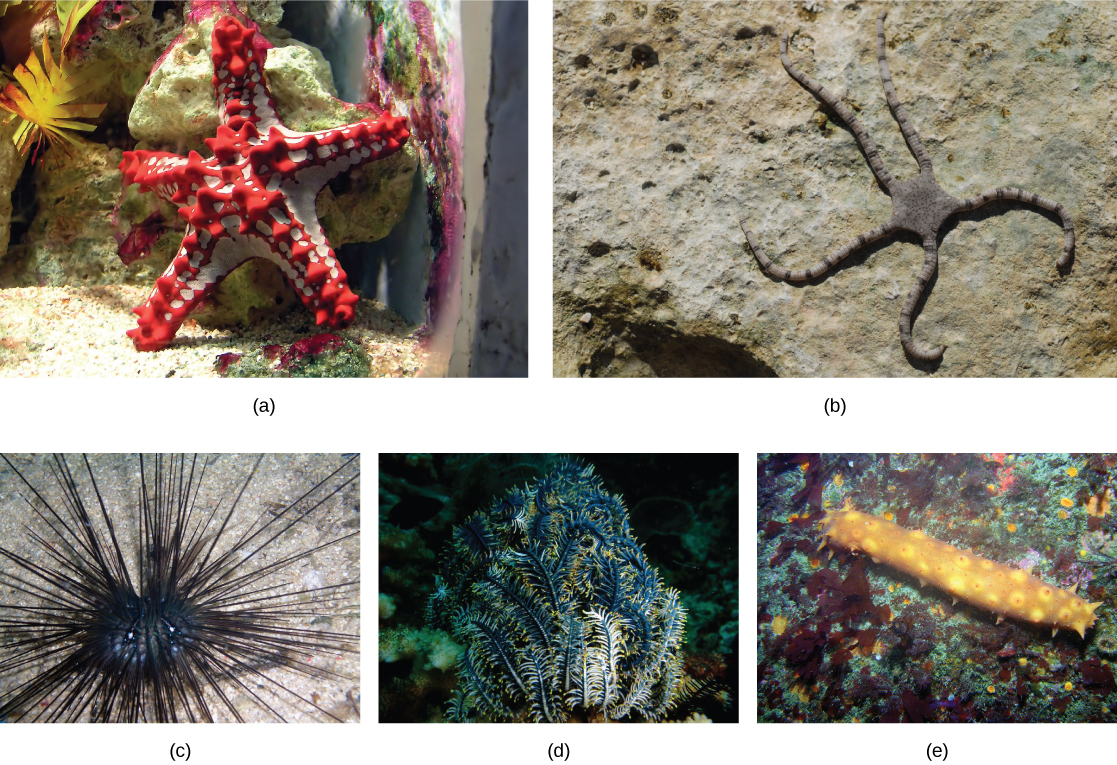| << Chapter < Page | Chapter >> Page > |
View this video to explore a sea star’s body plan up close, watch one move across the sea floor, and see it devour a mussel.
Brittle stars have long, thin arms that do not contain any organs. Sea urchins and sand dollars do not have arms but are hemispherical or flattened with five rows of tube feet, which help them in slow movement. Sea lilies and feather stars are stalked suspension feeders. Sea cucumbers are soft-bodied and elongate with five rows of tube feet and a series of tube feet around the mouth that are modified into tentacles used in feeding.

The majority of species in the phylum Chordata are found in the subphylum Vertebrata, which include many species with which we are familiar. The vertebrates contain more than 60,000 described species, divided into major groupings of the lampreys, fishes, amphibians, reptiles, birds, and mammals.
Animals in the phylum Chordata share four key features that appear at some stage of their development: a notochord, a dorsal hollow nerve cord, pharyngeal slits, and a post-anal tail ( [link] ). In certain groups, some of these traits are present only during embryonic development.
The chordates are named for the notochord , which is a flexible, rod-shaped structure that is found in the embryonic stage of all chordates and in the adult stage of some chordate species. It is located between the digestive tube and the nerve cord, and provides skeletal support through the length of the body. In some chordates, the notochord acts as the primary axial support of the body throughout the animal’s lifetime. In vertebrates, the notochord is present during embryonic development, at which time it induces the development of the neural tube and serves as a support for the developing embryonic body. The notochord, however, is not found in the postnatal stage of vertebrates; at this point, it has been replaced by the vertebral column (the spine).
The dorsal hollow nerve cord is derived from ectoderm that sinks below the surface of the skin and rolls into a hollow tube during development. In chordates, it is located dorsally to the notochord. In contrast, other animal phyla possess solid nerve cords that are located either ventrally or laterally. The nerve cord found in most chordate embryos develops into the brain and spinal cord, which compose the central nervous system.
Pharyngeal slits are openings in the pharynx, the region just posterior to the mouth, that extend to the outside environment. In organisms that live in aquatic environments, pharyngeal slits allow for the exit of water that enters the mouth during feeding. Some invertebrate chordates use the pharyngeal slits to filter food from the water that enters the mouth. In fishes, the pharyngeal slits are modified into gill supports, and in jawed fishes, jaw supports. In tetrapods, the slits are further modified into components of the ear and tonsils, since there is no longer any need for gill supports in these air-breathing animals. Tetrapod means “four-footed,” and this group includes amphibians, reptiles, birds, and mammals. (Birds are considered tetrapods because they evolved from tetrapod ancestors.)

Notification Switch
Would you like to follow the 'Concepts of biology' conversation and receive update notifications?